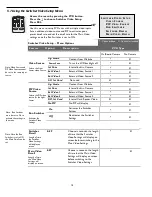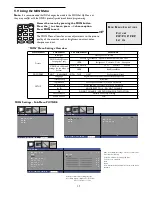
This label may appear on the bottom of the unit due to
space limitations.
The lightning flash with an arrowhead symbol
within an equilateral triangle is intended to
alert the user to the presence of uninsulated
"dangerous voltage" within the product's
enclosure that may be of sufficient magnitude
to constitute a risk of electric shock to
persons.
The exclamation point within an equilateral
triangle is intended to alert the user to
presence of important operating and
maintenance (servicing) instructions in the
literature accompanying the appliance.
CAUTION:
TO REDUCE THE RISK OF ELECTRICAL
SHOCK, DO NOT OPEN COVERS. NO USER
SERVICEABLE PARTS INSIDE. REFER SERVICING TO
QUALIFIED SERVICE PERSONNEL.
SAFETY PRECAUTIONS
2
1.
Read Instructions - All the safety and operating instructions should be read before
the unit is operated.
2.
Retain Instructions - The safety and operating instructions should be retained for
future reference.
3.
Heed Warnings - All warnings on the unit and in the operating instructions should
be adhered to.
4.
Follow Instructions - All operating and use instructions should be followed.
5.
Cleaning - Unplug the unit from the outlet before cleaning. Do not use liquid
cleaners or aerosol cleaners. Use a damp cloth for cleaning.
6.
Attachments - Do not use attachments not recommended by the product
manufacturer as they may cause hazards.
7.
Accessories - Do not place this unit on an unstable stand, tripod, bracket, or
mount. The unit may fall, causing serious injury to a person and serious damage
to the unit. Use only with a stand, tripod, bracket, or mount recommended by
the manufacturer or sold with the product. Any mounting of the unit should
follow the manufacturer's instructions and should use a mounting accessory
recommended by the manufacturer.
8.
Ventilation - Openings in the enclosure, if any, are provided for ventilation, to
ensure reliable operation of the unit, and to protect it from overheating. These
openings must not be blocked or covered. This unit should not be placed in a
built-in installation unless proper ventilation is provided or the manufacturer's
instructions have been adhered to.
9.
Power Sources - This unit should be operated only from the type of power
source indicated on the marking label. If you are not sure of the type of power
supply you plan to use, consult your appliance dealer or local power company.
For units intended to operate from battery power or other sources, refer to the
operating instructions.
10. Grounding or Polarization - This unit may be equipped with a polarized
alternating-current line plug (a plug having one blade wider than the other). This
plug will fit into the power outlet only one way. This is a safety feature. If you are
unable to insert the plug fully into the outlet, try reversing the plug. If the plug
should still fail to fit, contact your electrician to replace your obsolete outlet. Do
not defeat the safety purpose of the polarized plug.
Alternately, this unit may be equipped with a 3-wire grounding-type plug, a plug
having a third (grounding) pin. This plug will only fit into a grounding-type power
outlet. This is a safety feature. If you are unable to insert the plug into the outlet,
contact your electrician to replace your obsolete outlet. Do not defeat the safety
purpose of the grounding-type plug.
11. Power Cord Protection - Power supply cords should be routed so that they are
not likely to be walked on or pinched by items placed upon or against them,
paying particular attention to cords and plugs, convenience receptacles, and the
point where they exit from the appliance.
12. Power Lines - An outdoor system should not be located in the vicinity of
overhead power lines or other electric light or power circuits or where it can fall
into such power lines or circuits. When installing an outdoor system, extreme
care should be taken to keep from touching such power lines or circuits as
contact with them might be fatal. U.S.A. models only - refer to the National
Electrical Code Article 820 regarding installation of CATV systems.
13. Overloading - Do not overload outlets and extension cords as this can result in
system failure.
14. Object and Liquid Entry - Never push objects of any kind into this unit through
openings, as they may touch dangerous voltage points or short out parts that
could result in a fire or electric shock. Never spill liquid of any kind on the unit.
15. Servicing - Do not attempt to service this unit yourself as opening or removing
covers may expose you to dangerous voltage or other hazards. Refer all servicing
to qualified service personnel.
16. Damage Requiring Service - Unplug the unit from the outlet and refer servicing to
qualified service personnel under the following conditions:
a.
When the power supply cord or plug is damaged.
b.
If liquid has been spilled or objects have fallen into the unit.
c.
If the unit has been exposed to rain or water.
d.
If the unit does not operate normally by following the operating instructions.
Adjust only those controls that are covered by the operating instructions, as
an improper adjustment of other controls may result in damage and will
often require extensive work by a qualified technician to restore the unit to
its normal operation.
e.
If the unit has been dropped or the cabinet has been damaged.
f.
When the unit exhibits a distinct change in performance--this indicates a
need for service.
17. Replacement Parts - When replacement parts are required, be sure the service
technician has used replacement parts specified by the manufacturer or have the
same characteristics as the original part. Unauthorized substitutions may result in
fire, electric shock, or other hazards.
18. Coax Grounding - If an outside cable system is connected to the unit, be sure the
cable system is grounded. U.S.A. models only--Section 810 of the National
Electrical Code, ANSI/NFPA No.70-1981, provides information with respect to
proper grounding of the mount and supporting structure, grounding of the coax
to a discharge unit, size of grounding conductors, location of discharge unit,
connection to grounding electrodes, and requirements for the grounding
electrode.
I M PORTANT SAFEG UAR DS
Warning:
In a domestic environment, this
product may cause radio interference in
which case the user may be required to
take adequate measures.
ATTENTION – Observe Precautions
For Handling Electrostatic Sensitive Devices
What is Electrostatic Discharge?
A transfer of electrostatic charges between bodies at
different electrostatic potentials caused by direct contact or
induced by an electrostatic field. The following are some
examples of electrostatic charges:
1.
Walking across a nylon carpet on a dry day generates a
static electrical charge of 35,000 volts.
2.
Opening a plastic bag generates a charge of 20,000 volts.
W
ARNING
:
Do not make repairs yourself.
Do not attempt to remove the cover of
the NPVD. Do not disassemble it or
remove any parts.You run the risk of
electric shock and voiding the warranty.
No user-serviceable parts are inside.


































